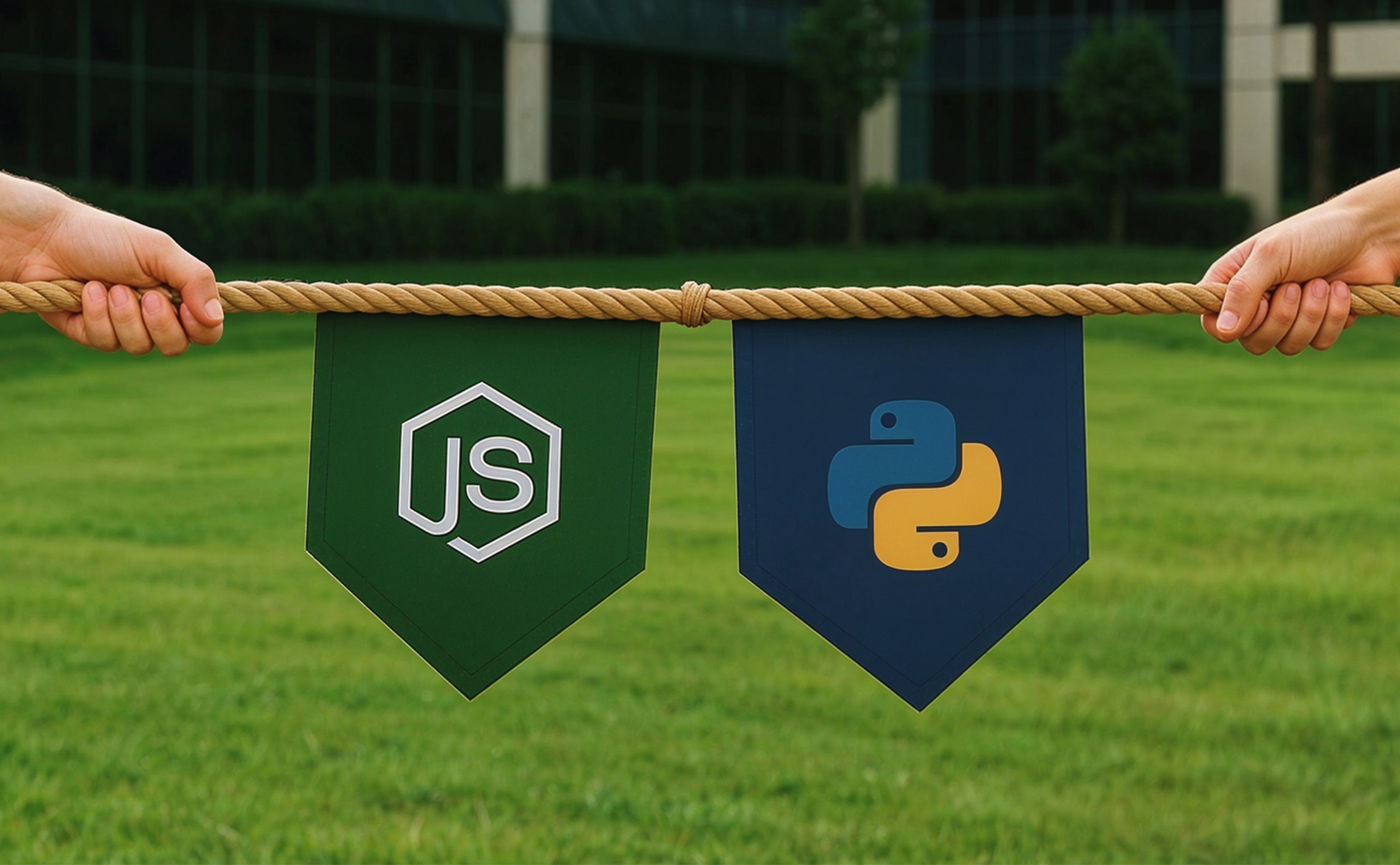Top 11 Backend Programming Languages in 2026

Backend languages are the programming languages that power websites and applications behind the scenes. While users interact with the front end the backend handles everything else - data processing, security, and server operations.
In 2025, choosing the right backend programming language is important for any digital project. Different languages serve different purposes - some excel at handling heavy traffic, others at processing complex calculations, and some at managing large databases.
With multiple backend languages available today, selecting the right one can significantly impact your project's performance, scalability, and maintenance costs. This article breaks down the most important backend languages for web development, comparing their strengths, uses, and limitations. Whether you're starting a new project or expanding an existing one, understanding these languages will help you make the right technical choice for your needs.
What is the Backend in Web Development?
Backend development is the server-side of web applications that handles everything users can't see - it processes data, manages databases, handles user authentication, and ensures the website/app works smoothly.
Think of modern web applications like an iceberg. The beautiful interface users interact with - that's just the 10% visible above water. The real magic happens beneath the surface, where backend developer languages handle everything from user authentication to data processing.
Key components of backend development include:
- Servers (processes requests)
- Databases (stores information)
- APIs (enables communication)
- Business Logic (processes operations)
Ready to Choose the Perfect Backend Solution?
Reach out to usLoading...
What are the Backend Languages?
Backend languages are programming languages that run on servers to process data, handle business logic, and manage databases.
Before learning about specific languages, let's understand why the choice of backend languages matters so much in 2025. These languages aren't just tools; they're the foundation of your digital infrastructure. Here's what makes them important:
Performance Impact
- Response time for user actions
- Server resource utilization
- Scaling capabilities
Development Speed
- Time to market
- Ease of finding developers
- Development cost
Maintenance Requirements
- Long-term sustainability
- Bug fixing efficiency
- Update management
Security Capabilities
- Built-in security features
- Vulnerability management
- Compliance capabilities
Let's explore the best language for backend development options available in 2025, analyzing their strengths, use cases, and why they might be the right choice for your project.
Best Backend Languages
1. Python
As the leading backend programming language in 2025, Python has revolutionized how we build web applications. Its remarkable growth comes from its readability and vast ecosystem. Companies choose Python because it cuts development time in half compared to traditional languages. For startups and enterprises alike, Python's Django and Flask frameworks make building robust web applications straightforward and cost-effective.
What makes Python great:
- The code looks almost like regular English
- Huge collection of free tools and add-ons
- Great for both simple and complex projects
- Works well with AI and data analysis
- Easy to find and fix mistakes
What to watch out for:
- Can be slower than other languages
- Uses more memory than some alternatives
- Not great for mobile apps
- Can get messy in very large projects
Companies using Python: Google, Dropbox, Pinterest, Reddit, Netflix, Instagram
2. JavaScript (Node.js)
As a versatile backend programming language, JavaScript through Node.js has transformed server-side development. Its ability to handle both frontend and backend makes it a cost-effective choice for businesses. The non-blocking, event-driven architecture makes it perfect for real-time applications that need to handle thousands of concurrent connections.
What makes JavaScript great:
- Same language for frontend and backend
- A huge community of developers
- Lots of free tools and packages
- Great for real-time features like chat
- Works well with modern web apps
What to watch out for:
- Code quality can vary widely
- Too many ways to do the same thing
- Security needs extra attention
- Can be tricky to maintain large projects
Companies using Node.js: PayPal, Walmart, NASA, Twitter, LinkedIn, Uber, Trello
3. Java
As one of the most established backend languages for web development, Java continues to dominate enterprise applications. Its "Write Once, Run Anywhere" capability makes it a reliable choice for cross-platform development. The Spring framework ecosystem provides enterprise-grade features that are out of the box.
What makes Java great:
- Works on any computer system
- Very good at handling big projects
- Strong security features
- Lots of experienced developers
- Great for large company systems
What to watch out for:
- Takes longer to write code
- Needs more computer memory
- Can be expensive to develop
- Harder to learn than some languages
Companies using Java: Amazon, Microsoft, Spotify, Airbnb, Zillow, eBay
4. PHP
Among backend developer languages, PHP remains a practical choice for web development. Its deep integration with HTML, headless architecture, and widespread hosting support make it particularly attractive for small to medium-sized businesses. The latest versions have significantly improved performance and security.
What makes PHP great:
- Easy to start learning
- Works with almost all web hosting
- Huge collection of ready-made tools
- Large community for support
- Cost-effective to develop
What to watch out for:
- Can lead to security issues if not careful
- Not as fast as newer languages
- Not great for mobile apps
Companies using PHP: Facebook, Wikipedia, Slack, Mailchimp, WordPress, Tumblr, Etsy
5. Golang
As an emerging force in backend languages, Golang combines simplicity with powerful performance. Google created it, and it's designed for modern cloud infrastructure and microservices architecture. Its concurrent programming features make it ideal for handling multiple tasks simultaneously.
What makes Golang great:
- Very fast performance
- Good at handling many users at once
- Easy to write and understand
- Built-in testing tools
- Great for cloud services
What to watch out for:
- Fewer Golang developers available
- A limited number of libraries
- Different approach to error handling
- Takes time to learn well
Companies using Go: Google, Uber, Twitch, Dropbox, American Express, PayPal
6. Rust
Among backend programming languages, Rust stands out for its memory safety and performance. It's becoming increasingly popular for systems programming and security-critical applications. Major companies choose Rust when reliability is non-negotiable.
What makes Rust great:
- Prevents common coding mistakes
- Very fast performance
- Excellent security features
- Good documentation
- Strong community support
What to watch out for:
- Hard to learn at first
- Takes longer to write code
- Fewer developers available
- Limited web frameworks
Companies using Rust: Mozilla, Dropbox, Cloudflare, Discord, Coursera, Figma, npm
7. Kotlin
As a modern backend developer language, Kotlin provides a more streamlined alternative to Java while maintaining full compatibility. Its null safety features and concise syntax make it increasingly popular for server-side development.
What makes Kotlin great:
- Works perfectly with Java code
- Safer and more modern than Java
- Fewer bugs in code
- Better features than Java
- Good tools and support
What to watch out for:
- Smaller community than Java
- Can be slower to compile
- Learning resources are limited
- Still maturing for backend use
Companies using Kotlin: Pinterest, Coursera, Trello, Netflix, Udemy, Atlassian, Base Camp- Project Management.
For businesses looking to leverage Kotlin’s growing capabilities in backend development, collaborating with experienced professionals can make a difference. You can also work with or hire Kotlin developers to build scalable, secure, and modern applications tailored to your needs.
8. C#
In the realm of backend languages for web development, C# offers a robust platform for enterprise applications. Its integration with the .NET ecosystem makes it a powerful choice for Windows-based and cross-platform development.
What makes C# great:
- Excellent development tools
- Good for many types of applications
- Strong security features
- Regular updates
- Large developer community
What to watch out for:
- Works best with Microsoft tools
- Can be expensive to host
- Learning curve for beginners
- Less popular for startups
Companies using C#: Microsoft, Stack Overflow, Unity Games, Dell
9. C++
As a foundational backend programming language, C++ continues to dominate performance-critical applications. Its combination of low-level hardware access and high-level abstractions makes it irreplaceable in systems that demand maximum performance.
What makes C++ great:
- Extremely fast
- Direct hardware control
- Great for complex systems
- Widely used in gaming
- Strong performance
What to watch out for:
- Very difficult to learn
- Easy to make mistakes
- Takes long to develop
- Complex to maintain
Companies using C++: Google, Microsoft, Adobe, Oracle, Meta, NASA, Amazon Hub Counter, LinkedIn
10. Elixir
In the realm of backend languages, Elixir shines for its fault tolerance and scalability. Built on the Erlang VM, it's designed for distributed applications that require high availability and concurrent processing.
What makes Elixir great:
- Excellent at handling many users
- Rarely crashes
- Good for real-time features
- Easy to maintain
- Modern tools
What to watch out for:
- Hard to find developers
- Different ways of thinking required
- Limited use in some areas
- Smaller ecosystem
Companies using Elixir: Discord, Pinterest, Postmates, Moz, PepsiCo, Bleacher Report, Lonely Planet
11. Scala
Scala combines object-oriented and functional programming paradigms as a sophisticated backend programming language. It runs on the JVM and offers high scalability for complex applications.
What makes Scala great:
- Works with Java systems
- Good for big data
- Strong safety features
- Flexible programming
- Handles complex tasks well
What to watch out for:
- Complex to learn
- Needs experienced developers
- Can be overkill for simple projects
- Smaller job market
Companies using Scala: Twitter, LinkedIn, Netflix, Airbnb, Coursera, Morgan Stanley, SoundCloud
Need Help Selecting the Right Backend Tech?
Let's talkLoading...
Bottom Line
Choosing the right backend language is more than a technical decision - it's a strategic business choice that impacts your application's performance, maintenance costs, and scalability. While Python and JavaScript dominate the current landscape of most used backend language options, each language in our list offers unique advantages for specific use cases.
For businesses looking to implement these technologies, partnering with an experienced web development company in India is crucial. A professional web development agency can help navigate these choices and implement the most suitable solution for your specific needs.
Whether you're building a simple website or a complex enterprise application, the backend language you choose will significantly impact your project's success. At WAC, our team includes both skilled Python developers and experienced JavaScript developers, enabling us to deliver flexible, modern, and high-performing backend solutions that drive your business forward.
FAQs
- Python's main feature is that it is readable and has many libraries.
- Node.js enables a full-stack application to be developed using a single language.
- Java is strong and scalable for building large applications.
- PHP can be used to build websites and web apps. PHP has many tools, libraries, and frameworks (such as Laravel, WordPress, etc.) that help developers to build websites and web apps quickly and easily.
- Go can be used to increase performance and handle concurrent tasks.
- Rust guarantees memory safety and performance for system-level programming.
Discover Digital Transformation
Please feel free to share your thoughts and we can discuss it over a cup of tea.









